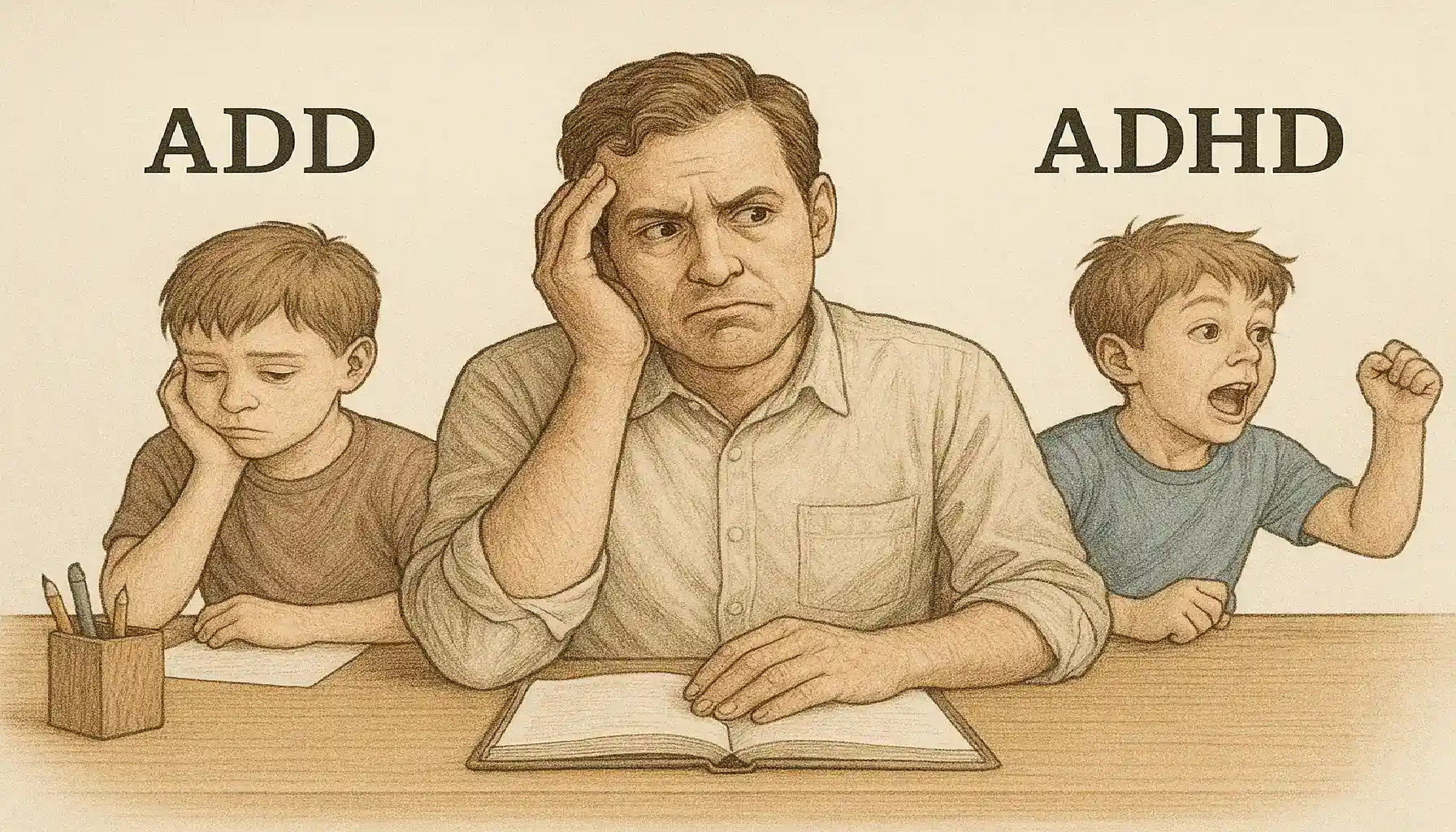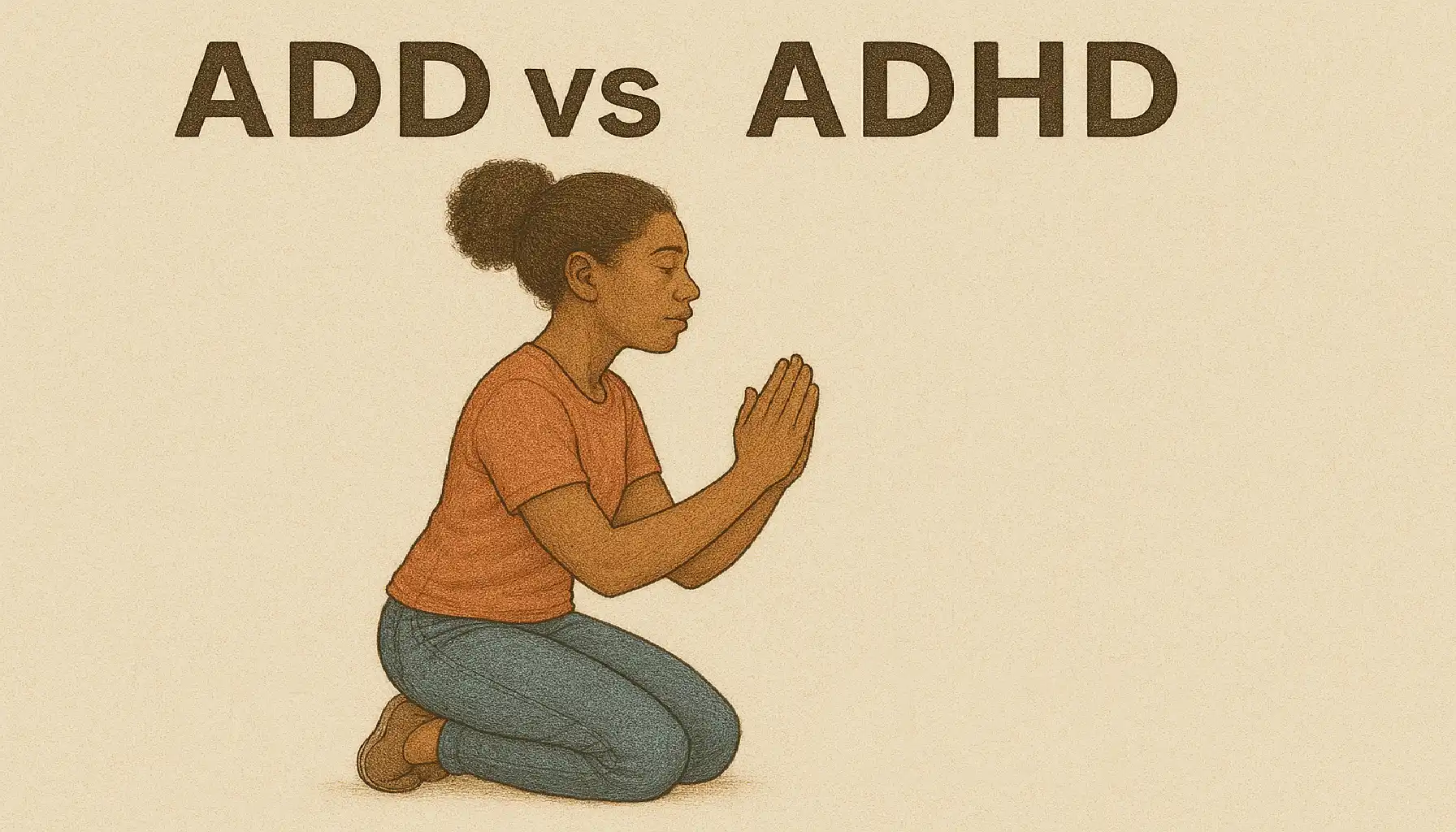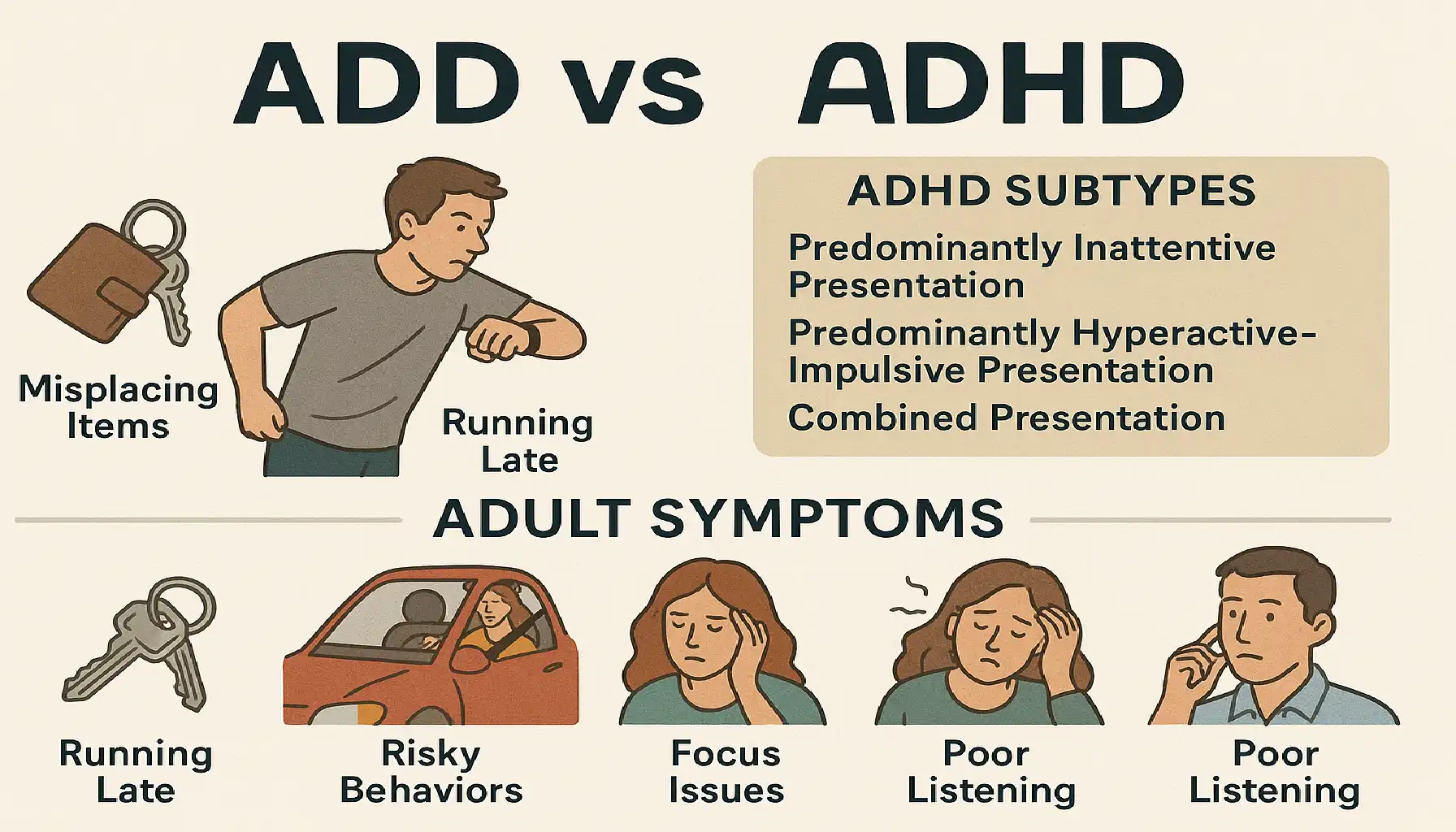Contents:
ADD once described a form of ADHD without hyperactivity. Clinicians used “ADD” in the 1980s to label inattentive presentations. Over time, research showed that these symptoms fit under one umbrella, so experts replaced ADD with ADHD in official guidelines. This change ended questions about the difference, but many still ask the difference between ADD and ADHD in casual conversation.
Today, doctors recognize three ADHD subtypes: predominantly inattentive, predominantly hyperactive-impulsive, and combined. People often wonder, is there a difference between ADHD and ADD, because they hear both terms in schools and offices. Clinicians now ask, what’s the difference between ADD and ADHD? Understanding these subtypes feels like a simple brain exercise for anyone learning about attention challenges.

What’s the Difference Between ADD and ADHD in Adults?
Adults often ask what is the difference between ADD and ADHD in adults when they struggle with drifting attention. Inattentive-type ADHD can look like daydreaming, missed details, and mental fog. This subtype rarely shows the classic restlessness and fidgeting of hyperactive ADHD. Professionals now classify these symptoms under one diagnosis to improve clarity.
Clinicians explain the difference between ADHD and ADD in adults by comparing core traits. The inattentive presentation causes forgetfulness, poor follow-through, and disorganization. The hyperactive-impulsive type produces constant movement, interrupting, and quick decisions. Each subtype affects work, relationships, and self-esteem in distinct ways.
Many people wonder is there a difference between ADD and ADHD in adults when they see mixed symptoms. Some adults feel anxious or overwhelmed even without physical hyperactivity. Others display mild impulsivity but struggle mostly with focus. Recognizing subtype differences guides personalized strategies and support
Understanding the difference between ADD and ADHD in adults helps shape treatment and lifestyle adjustments. Doctors may choose stimulant or non-stimulant medications based on subtype. Behavioral therapies and coaching target specific challenges like time management or impulse control. Tailored plans lead to better outcomes and daily success.

Symptom Category | Predominantly Inattentive ADHD | Predominantly Hyperactive-Impulsive ADHD |
Attention Span | Sustained poor focus on tasks | Brief focus, rapid task switching |
Impulsivity | Low frequency of spontaneous actions | High frequency of unplanned behaviors |
Hyperactivity | Rare; appears calm | Frequent movement and restlessness |
Forgetfulness | Often forgets appointments and deadlines | May forget due to shifting attention |
Organization | Disorganized, messy workspaces | Disruption from impulsive choices |
How ADD and ADHD Show Up in Children
Parents often ask what is the difference between ADD and ADHD in children when their child seems to drift off during lessons. The difference between ADD and ADHD in children shows in how kids handle tasks. Inattentive-type children miss details, while hyperactive ones move constantly. The difference between ADHD and ADD in children affects peer play and learning style.
Doctors face hurdles in sorting symptoms and avoiding mislabels. Many families ask whats the difference between ADD and ADHD in children when reports vary. Others wonder whats the difference between ADHD and ADD in kids if signs mix. The difference between ADD and ADHD in kids often needs careful observation over time.
Common Symptoms in Kids:
Difficulty following instructions: Children start tasks but forget steps.
Easily distracted: They shift attention with every sound.
Fidgeting or leaving seat: They cannot stay still during circle time.
Impulsive speech or actions: They speak out or act without waiting.

Differences Between ADD and ADHD in Women
Many women wonder what is the difference between ADD and ADHD in women when they see quiet distractibility but no hyperactivity. They often develop coping strategies that mask symptoms, leading to late diagnoses. Clinicians note that women with inattentive ADHD present more subtle signs, such as daydreaming in meetings.
Emotional regulation plays a major role in the difference between ADD and ADHD in women. Women with ADD tend to internalize stress, blaming themselves for missed deadlines. Those with combined experience frustration and impulsive reactions, which peers and teachers notice more readily. Understanding these patterns helps tailor support and treatment.
Experts still ask difference between ADHD and ADD in women when research shows underdiagnosis remains common. Some professionals also question whats the difference between ADD and ADHD in women as they track symptom evolution over time. Raising awareness of female presentations can close the diagnosis gap and improve outcomes.

Trait | ADD Presentation | ADHD (Combined) |
Focus Issues | Quiet daydreaming; misses details without notice | Jumps between tasks; struggles to finish projects |
Emotional Impact | Anxiety, self-blame, low self-esteem | Frustration, impulsivity, frequent mood swings |
Diagnosis Timeline | Often diagnosed in adulthood | Frequently identified in childhood or teens |
Coping Strategy | Creates rigid routines to stay organized | Uses external reminders and support systems |
Core Symptom Differences Between ADD and ADHD
The DSM-5 outlines clear criteria to diagnose. It groups symptoms into three clusters to show the difference between ADD and ADHD symptoms. Clinicians count behaviors like inattention, impulsivity, and hyperactivity over six months. They use checklists to ensure consistent evaluation across ages.
Inattentive type matches classic “ADD” without much movement. Hyperactive-Impulsive type shows constant motion and hasty actions. Providers ask what the difference between ADD and ADHD by checking which behaviors dominate and how they impair daily life.
Combined type meets criteria for both clusters. Children and adults in this category juggle daydreaming with high energy. Therapists tailor treatments based on the dominant symptom pattern.
ADHD Symptom Clusters:
Inattentive (classic “ADD”): Makes careless mistakes, loses track of tasks, and drifts off easily.
Hyperactive-Impulsive: Fidgets, interrupts often, and acts without thinking.
Combined Type: Exhibits both inattention and hyperactive-impulsive behaviors significantly.

How Much of a Difference Does It Really Make?
Many people ask how much difference between ADD and ADHD truly matters when they see mixed symptoms. Although experts define subtypes, most individuals exhibit both inattentive and hyperactive traits.
They experience challenges with focus, impulsivity, and restlessness in varying degrees. Champions like Simone Biles, who is one of the famous people with inattentive ADHD, show that these traits often overlap on the path to success. This overlap proves that strict labels can miss the full picture of each person’s profile.
Treatment and lifestyle strategies often help both subtypes equally for attention deficit hyperactivity disorder, even though ADD remains an outdated term.
Clinicians recommend combining medication, behavioral therapy, and structured daily routines in line with american psychiatric standards that note symptoms like talks excessively. Regular exercise, mindfulness practice, and clear goal-setting support steady progress.
Innovators like Sir Richard Branson, who is a famous people with ADD/ADHD, use rigorous schedules and creative outlets to manage their strengths. You can tailor these approaches to match your needs and thrive every day.
Quick Checklist: How to Tell ADD and ADHD Apart
Use this simple self-reflective guide to answer what’s the difference between ADHD and ADD? Think about your daily habits and ask yourself clear questions. Write down your answers and look for patterns over a week. Honest notes reveal whether you lean more toward quiet inattention or active impulsivity.
Parents often ask whats the difference between ADHD and ADD in kids when they watch their child at play or in class. Adults may wonder about the difference between ADHD and ADD adults when they juggle work and home tasks. If you see mixed signs, talk with a qualified professional. Only a clinician can confirm a diagnosis and recommend next steps.
Questions to Ask Yourself:
№ | Question | Yes | No |
1 | Do I often start tasks but struggle to complete them? | ||
2 | Do I lose or misplace important items more than most people? | ||
3 | Do I find it hard to remain seated or still when expected? | ||
4 | Do I interrupt others or speak out of turn in conversations? | ||
5 | Do I postpone projects until the last possible moment? | ||
6 | Do I have trouble organizing daily responsibilities? | ||
7 | Do I feel overwhelmed by routine tasks or simple chores? | ||
8 | Do I get easily distracted by unrelated thoughts or noises? |
Scoring Tip: If you checked “Yes” for more than half the questions, consider consulting a professional for a formal assessment.





